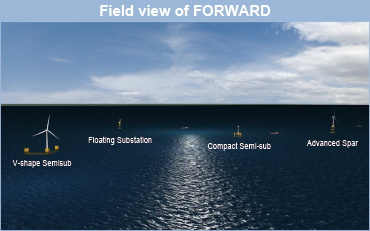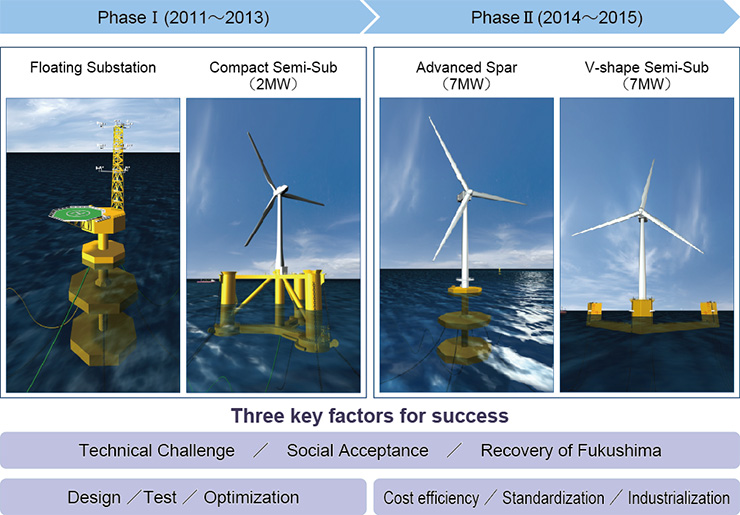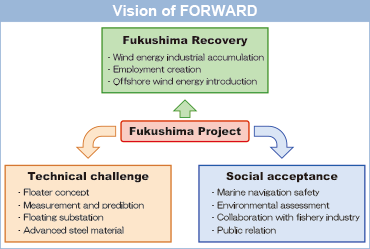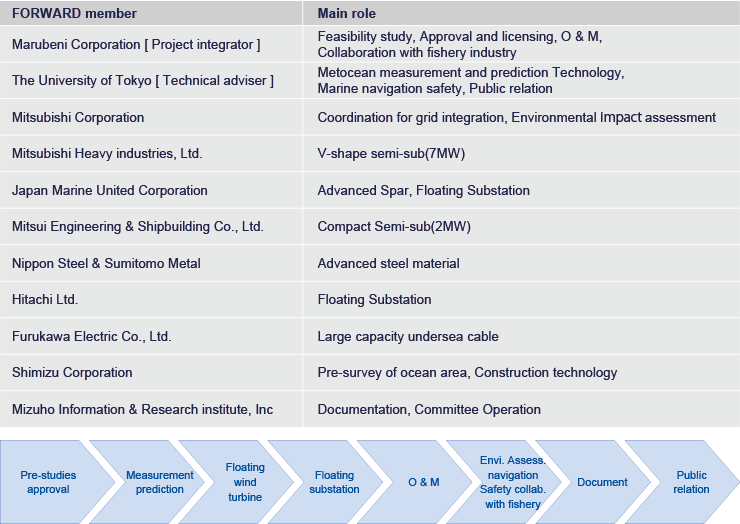Policy
![]()

Fukushima offshore wind consortium, which consists of Marubeni Corporation (Project integrator), the University of Tokyo(Technical advisor), Mitsubishi Corporation, Mitsubishi Heavy Industries, Japan Marine United Corporation, Mitsui Engineering & Shipbuilding, Nippon Steel & Sumitomo Metal Corporation, Ltd., Hitachi Ltd., Furukawa Electric Co., Ltd., Shimizu Corporation and Mizuho information & Research, is proceeding with Fukushima floating offshore wind farm demonstration project (Fukushima FORWARD) funded by the Ministry of Economy, Trade and Industry.
In this project, three floating wind turbines and one floating power sub-station will be installed off the coast of Fukushima. The first phase of the project consists of one 2MW floating wind turbine, the world first 25MVA floating substation and undersea cable have been completed on November 11, 2013. In the second phase two world largest 7MW wind turbines will be installed before 2015.
This project will establish the business-model of the floating wind farm and contribute to future commercial projects. The consortium members are also expected to learn know-how of floating offshore wind farm, which will be one of the major export industries in Japan.
The Fukushima FORWARD project believes to help Fukushima to become the center of new industry which will create new employment in this region recover from the damage of the Great East Japan Earthquake in 2011.
Scope of FORWARD

![]()

Two decades have passed since the first bottom-mounted offshore wind turbine was installed in Europe and many large scale commercial projects are in operation now. On the other hand, a few floating offshore wind turbine(FOWT) has been installed as a pilot project in Norway and Portugal. Several technical questions such as floater optimization and transmission system need to be solved for future large scale projects.
A V-Shape semi-sub floater with the world largest 7MW turbine, the world first 25MVA floating substation and the 66kV undersea cable will be implemented in Fukushima project and the economical feasibility will be studied.
A metocean measurement system considering the floater motion compensation will be developed in order to evaluate the performance and the motion of FOWT. Furthermore, the characteristics of each floater and the wind turbine, and the effect of control system on floater motion will be investigated.
In addition, the advanced steel material against corrosion and fatigue and construction technology under severe weather condition will be developed.
The project will not only focus on technical challenges but also on collaboration with fishery industry, marine navigation safety and environmental assessment, which are needed for the future large offshore floating wind farm. Public relations work will be carried out so that the status and results of this project will be open to public.
FORWARD member and Main role









